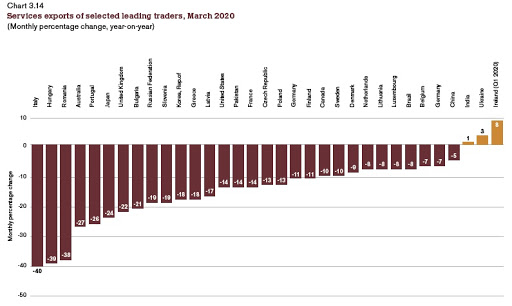One early indicator of trade are based on data from purchasing managers and the new orders they have received for goods that will be exported. The sharp fall, and then the rebound, suggest that the level of these orders may have bottomed out in March or April, and that a recovery in actual exports may be perceptible in the June data.
Here's a measure of the quantity of container shipping. Notice that the fall in the last few months is not (yet) as deep or severe as the decline during the Great Recession.
As one might expect, the number of commercial flights plummeted, falling by something like three-quarters in March 2020.
Tourism and travel is a major elements of international trade: for example, when a foreign traveler in the US spends money on US goods and services, it is treated in the trade statistics as an "export" of US production to a foreign consumer. The US typically runs a surplus in travel industry, with exports (blue line) well above imports (gray line), but both have dropped substantially in early 2020.
Finally, here are a couple of figures comparing national-level data on exports in April 2020 and on imports in March 2020 to the monthly data for a year earlier.
Those who believe that international trade is bad for the US economy should of course welcome the 2020 fall in trade as a silver lining in what is otherwise shaping up to be a dismal year for the economy. Or alternatively, they might reconsider the extent to which trade is the fundamental source of US economic problems or reducing trade is a useful solution to those problems.





